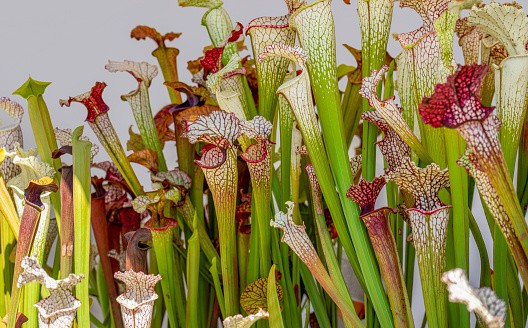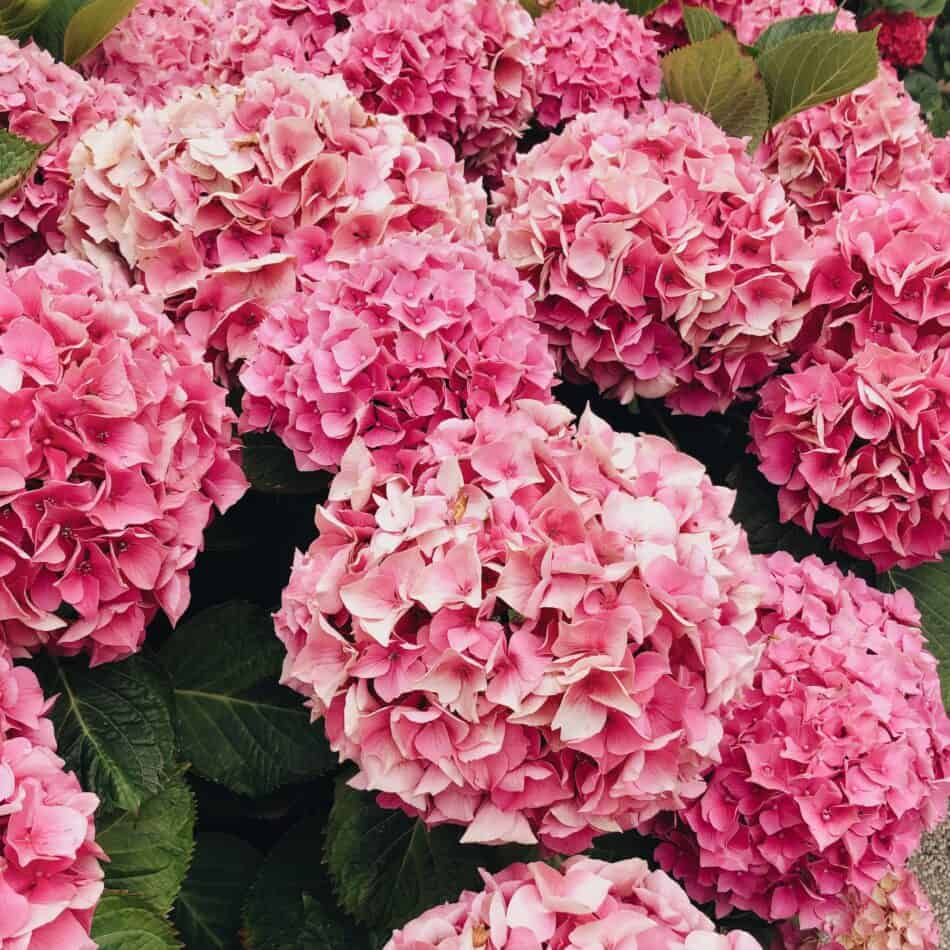This fascinating carnivorous perennial is noted for its upright, slender pitchers, producing two rounds of crops for extended seasonal interest. They begin as green in color and gradually turn into white with brown veins, with frilled lids. In the springtime, they produce bright red flowers that are somewhat fragrant. Insects are captivated by the irresistible pitchers and become stunned by the nectar, eventually falling into the tubes. This plant grows up to 36 inches and needs moist soil.
The White-Topped Pitcher Plant, or Sarracenia leucophylla, belongs to the family Sarraceniaceae. It is a perennial plant and is native to the southeastern United States, primarily in the coastal belt from Virginia to Florida.
Meaning and Symbolism
The White-Topped Pitcher Plant is known as the “Lovely White-crowned Pitcher” due to the white flower and tall pitchers that form its crown. It is a symbol of patience and endurance, representing the ability of this plant to withstand the harsh conditions of its environment.
History, Mythology, and Religious Significance
The White-Topped Pitcher Plant has long been a symbol of purity and innocence, with many European cultures believing it to be a talisman against evil. In Ancient Greek and Roman cultures, it was thought to represent everlasting life and resurrection, while many Native American cultures used it as an offering to their gods.
In Christianity, the White-Topped Pitcher Plant is often a symbol of Christ’s power and sovereignty. It can be seen as a reminder of His miraculous resurrection and the promise of eternal life for those who believe in Him and follow His teachings.
Flower Varieties and Their Defining Characteristics:
The White-Topped Pitcher Plant has several varieties, each of which has unique features and characteristics:
The ‘Adrian’ variety is the most common, with pitchers with a reddish coloration and strongly scented flowers, resembling those of the white-crowned pitcher plant.
The ‘Enina’ variety has pitcher-shaped flowers with a deep pink color and a strong grape scent.
The ‘Venus’ variety has pitchers with a creamy yellow flower, and a bright yellow flower on the outside.
The ‘White Lace’ variety is characterized by a whitish foliage and delicate, white flowers.
How to Plant
White-Topped Pitcher Plant can thrive in almost any level of light. It grows best in direct sunlight, preferably in bright, indirect light as it can easily burn in direct sun. Use a high-quality, well-draining soil that is slightly acidic. The soil should be kept evenly moist, though be sure not to overwater, which can cause root rot. Keep the temperature above 55ºF when growing this plant.
How to Pot and Repot
When potting White-Topped Pitcher Plant, use a pot that has good drainage and is wide enough to accommodate the roots. Fill the pot with a slightly acidic potting mix. Plant the White-Topped Pitcher Plant in the center of the pot, making sure to leave some room between the plant and the pot’s rim. Water the plant immediately after planting and place it in a sunny area. If the pot is too large or too small the plant may not thrive, so pick the right pot size for the plant.
Repotting should be done every two to three years, as the soil may become depleted of nutrients over time. It is best to repot at the beginning of the growing season. Prepare your new pot by filling it with fresh soil and a balanced fertilizer. Carefully lift White-Topped Pitcher Plant from its old pot and place it in the new pot, making sure to cover the roots completely. Water the plant until the soil is moist and then keep the soil moist in its new pot.
How to Prune
To ensure healthy growth, prune dead or unhealthy leaves and stems regularly throughout the growing season. Cut just below the damaged area, leaving a healthy portion of the stem or leaf uncut. It is important to use clean, sharp pruning shears as they will cause less damage to the plant. Pruning White-Topped Pitcher Plant helps encourages branching, producing a bushier and healthier plant.
How to Propagate
White-Topped Pitcher Plant can be propagated by both seeds and cuttings. Propagating from seeds is done by sowing the tiny, black seeds in a sterile, moist soil. Gently sprinkle the seeds on the soil, cover them with a thin layer of soil, and keep them moist. If propagating via cuttings, use a 6-inch stem with at least two nodes and cut just below one node. Dip the cutting in a rooting hormone, then plant in a moist soil and keep the soil evenly moist. The cutting should root within several weeks.
Common Pests and Diseases
White-Topped Pitcher Plant is susceptible to White Fly and Aphids, which can be damaging to the flowers. Mealybugs and Spider Mites can also affect the plant. To treat White-Topped Pitcher Plant for pests and diseases, use a fungicide, insecticide, or horticultural oil on the leaves and stems, being sure to protect the plant from direct sun and humidity.
Three Frequently Asked Questions
1. How long will it take for a White-Topped Pitcher Plant to flower?
It can take between one and two years for White-Topped Pitcher Plant to flower, depending on the variety. Flowering occurs in the summer.
2. Are White-Topped Pitcher Plants easy to care for?
If given the appropriate care and environment, White-Topped Pitcher Plants are generally quite easy to care for. Just make sure to provide the right amount of sunlight, water, and fertilizer, and they should thrive.
3. What type of humidity does a White-Topped Pitcher Plant need?
White-Topped Pitcher Plant prefers a higher level of humidity (around 50 percent) in order to stay healthy and flower. You can increase the humidity by misting the plant throughout the day or placing a tray of water beneath its pot.
Table Fact Sheet
| Plant Name | White-Topped Pitcher Plant |
| Scientific Name | Sarracenia Leucophylla |
| Family | Sarraceniaceae |
| Plant Type | Perennial |
| Mature Size | Up to 36 inches |
| Sun Exposure | Bright, indirect light |
| Soil Type | High-quality, well-draining soil |
| Soil pH | Slightly acidic |
| Bloom Time | Spring |
| Flower Color | Red |
| Hardiness Zones | 6 to 9 |
| Native Area | Southeastern United States |
What we love from Amazon this week
Buy these wonderful flowers directly from Amazon:















